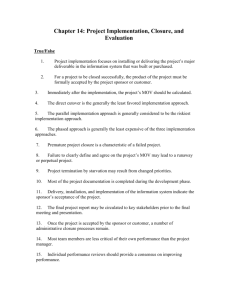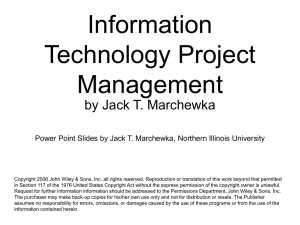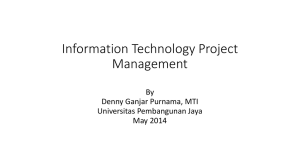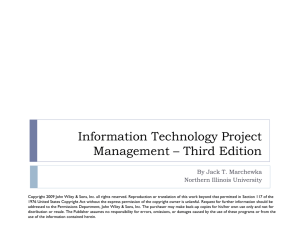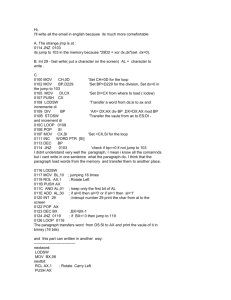CHAPTER OBJECTIVES
advertisement
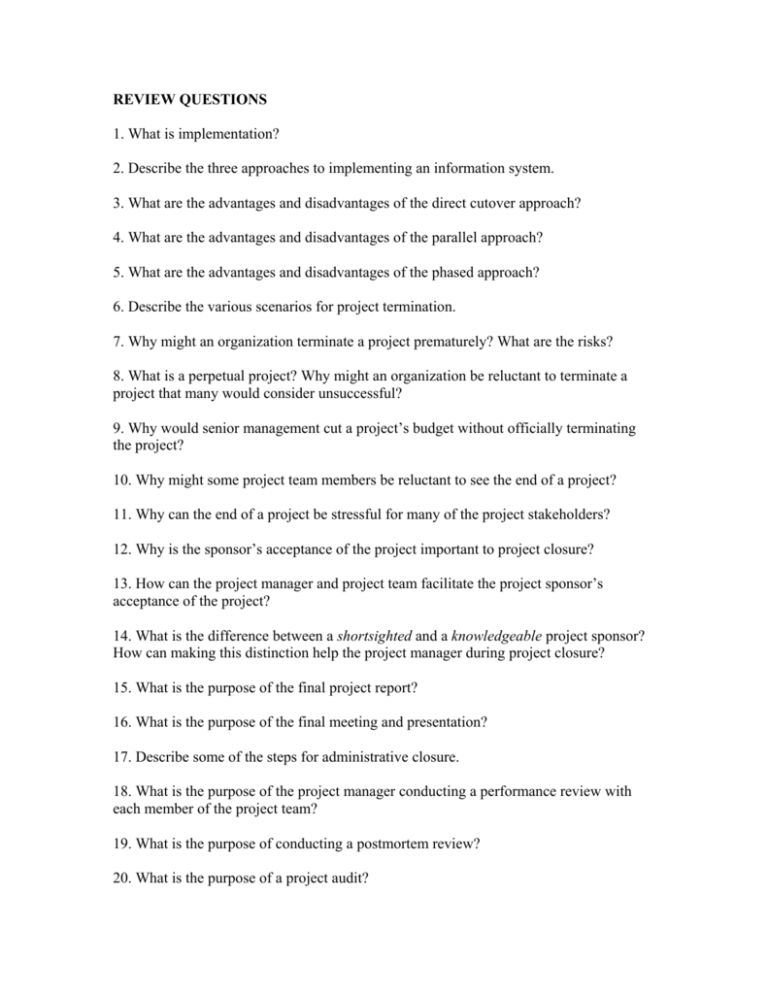
REVIEW QUESTIONS 1. What is implementation? 2. Describe the three approaches to implementing an information system. 3. What are the advantages and disadvantages of the direct cutover approach? 4. What are the advantages and disadvantages of the parallel approach? 5. What are the advantages and disadvantages of the phased approach? 6. Describe the various scenarios for project termination. 7. Why might an organization terminate a project prematurely? What are the risks? 8. What is a perpetual project? Why might an organization be reluctant to terminate a project that many would consider unsuccessful? 9. Why would senior management cut a project’s budget without officially terminating the project? 10. Why might some project team members be reluctant to see the end of a project? 11. Why can the end of a project be stressful for many of the project stakeholders? 12. Why is the sponsor’s acceptance of the project important to project closure? 13. How can the project manager and project team facilitate the project sponsor’s acceptance of the project? 14. What is the difference between a shortsighted and a knowledgeable project sponsor? How can making this distinction help the project manager during project closure? 15. What is the purpose of the final project report? 16. What is the purpose of the final meeting and presentation? 17. Describe some of the steps for administrative closure. 18. What is the purpose of the project manager conducting a performance review with each member of the project team? 19. What is the purpose of conducting a postmortem review? 20. What is the purpose of a project audit? 21. What criteria should be used to choose a project auditor or auditing team? 22. What is the purpose of evaluating the project’s MOV? 23. Why would it be difficult to evaluate whether or not a project achieved its MOV shortly after the information system is implemented? 24. Why should any lessons learned from project evaluations be documented? 25. Why would evaluating whether a project achieved its MOV make many project managers and teams anxious? Why should it still be done? True/False 1. Project implementation focuses on installing or delivering the project’s major deliverable in organization-the information system that was built or purchased. True/False __________ 2. For a project to be closed successfully, the product of the project must be formally accepted by the project sponsor or customer. True/False __________ 3. Immediately after the implementation, the project’s MOV should be calculated. True/False __________ 4. The direct cutover is the generally the least favored implementation approach. True/False __________ 5. The parallel implementation approach is generally considered to be the riskiest implementation approach. True/False __________ 6. The phased approach is generally the least expensive of the three implementation approaches. True/False __________ 7. Premature project closure is a characteristic of a failed project. True/False __________ 8. Failure to clearly define and agree on the project’s MOV may lead to a runaway or perpetual project. True/False __________ 9. Project termination by starvation may result from changed priorities. True/False __________ 10. Most of the project documentation is completed during the development phase. True/False __________ 11. Delivery, installation, and implementation of the information system indicates the sponsor’s acceptance of the project. True/False __________ 12. The final project report may be circulated to key stakeholders prior to the final meeting and presentation. True/False __________ 13. Once the project is accepted by the sponsor or customer, a number of administrative closure processes remain.. True/False __________ 14. Most team members are less critical of their own performance than the project manager. True/False __________ 15. Individual performance reviews should provide a consensus on improving performance. True/False __________ 16. Conducting the postmortem review is the responsibility of the project sponsor. True/False __________ 17. The project audit is the generally conducted by the project manager and project team. True/False __________ 18. The project MOV is usually readily determined at the close of the project. True/False __________ 19. Before conducting the final project evaluation, one must be sure that information system delivered has not been changed by the users or support staff. True/False __________ 20. The final arbiter of project success is the evaluation of the project’s MOV. True/False __________ Multiple Choices 12-01 Which implemention approach usually entails the greatest level of risk? a) b) c) d) e) Direct Cutover Parallell Phased All of the above None of the above Answer: ________ 12-02 Which implemention approach involves no risk? a) b) c) d) e) Direct Cutover Parallell Phased All of the above None of the above Answer: ________ 12-03 Which implemention approach is usually the most expensive and least risky? a) b) c) d) e) Direct Cutover Parallell Phased All of the above None of the above Answer: ________ 12-04 Which implementation approach allows for implementation of modules in different departments or locations? a) b) c) d) e) Direct Cutover Parallell Phased All of the above None of the above Answer: ________ 12-05 Which termination circumstance is one in which the project is completed as planned? a) b) c) d) Normal Premature Perpetual Failed e) Changed Priority Answer: ________ 12-06 Which termination circumstance is one in which the project is ended because the cost of completing it are greater than the potential benefits of completing it. a) b) c) d) e) Normal Premature Perpetual Failed Changed Priority Answer: ________ 12-07 Another name for a runaway project is: a) b) c) d) e) Normal Premature Perpetual Failed Changed Priority Answer: ________ 12-08 As a result of competitor's actions, a project was pushed to completion without all of the envisioned features. This project termination is termed __________ ? a) b) c) d) e) Normal Premature Perpetual Failed Changed Priority Answer: ________ 12-09 The most important requirement for project closure under normal circumstances is: a) b) c) d) e) completing the project on time. completing the project on or under budget. redeploying team members successfully to other projects. following the project methodology. obtaining the project sponsor's acceptance of the project. Answer: ________ 12-10 The final project report should include: a) b) c) d) e) Project Summary Comparison of Planned vs. Actual Outstanding Issues Project Documentation List All of the above Answer: ________ 12-11 Discussing team members' next assignment is generally a part of: a) b) c) d) e) Individual Performance Review Postmortem Review Project Audit MOV Evaluation Answer: ________ 12-12 Having the team review the project scope, schedule, budge, and quality objectives would most likely occur in the: a) b) c) d) e) Individual Performance Review Postmortem Review Project Audit MOV Evaluation Answer: ________ 12-13 An outside party would be more likely to be called in for the: a) b) c) d) e) Individual Performance Review Postmortem Review Project Audit MOV Evaluation Answer: ________ 12-14 In the final analysis, project success is determined in the: a) Individual Performance Review b) Postmortem Review c) Project Audit d) MOV Evaluation e) Answer: ________ Short Question 1. Describe the direct cutover approach to project implementation. What are the strengths and weaknesses of this approach? Page ______ 2 Describe the parallel approach to project implementation. What are the strengths and weaknesses of this approach? Page ______ 3. Describe the phased approach to project implementation. What are the strengths and weaknesses of this approach? Page ______ 4. Gray and Larson define five circumstances for ending a project. Name and briefly describe them. Page ______ 5. What are some of the realities that the text discusses that occur instead of the normal closure with happy sponsors and customers and a successful achievement of the project MOV? Page ______ 6. What are the essential elements of the final project report? Page ______ 7. What is the purpose of the final meeting and presentation? Page ______ 8. Conducting individual performance reviews is an important responsibility of the project manager. What are some of the sensitivities that the project manager should exhibit and what benefits can accrue to the team member? Page ______ 9. Who should ideally conduct the project audit and what are the characteristics of a good audit team member? Page ______ 10. How should the project be evaluated in the end to determine its success or failure? Page ______
